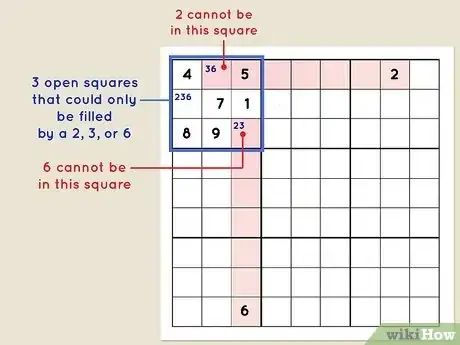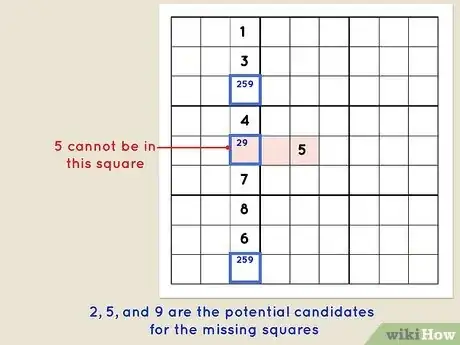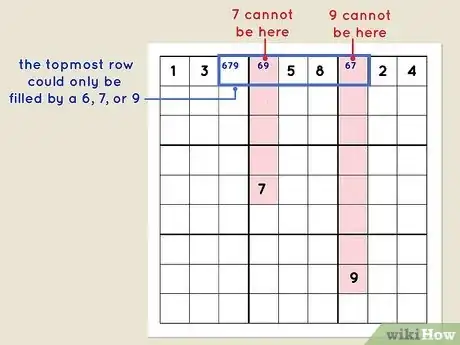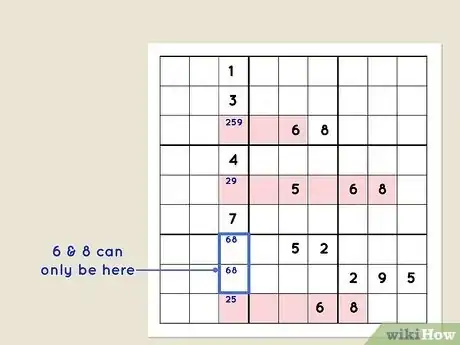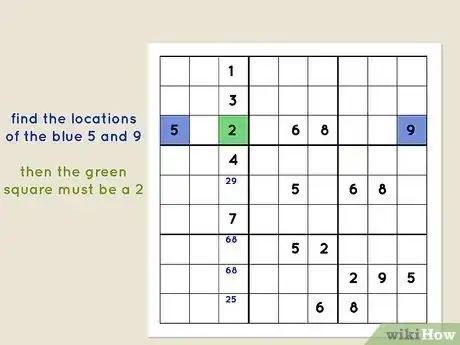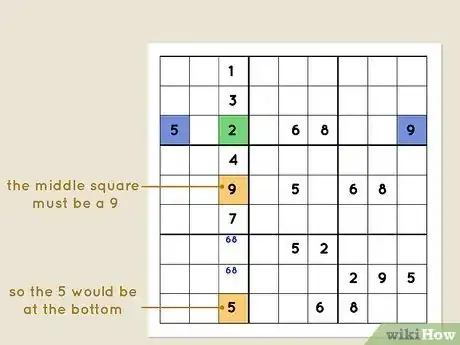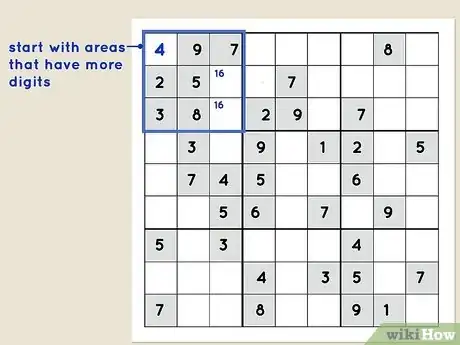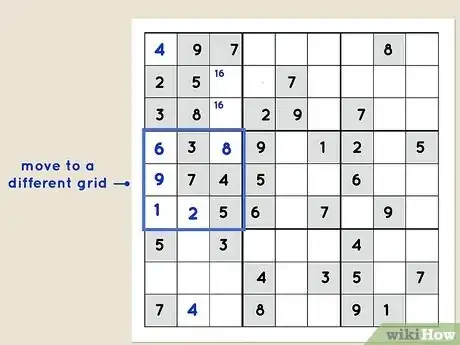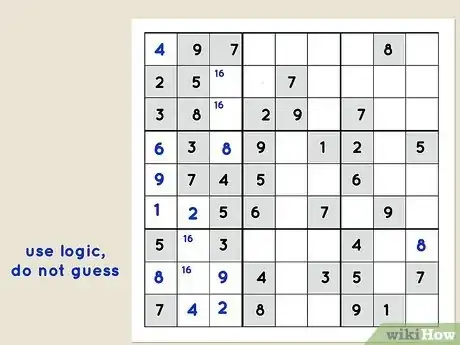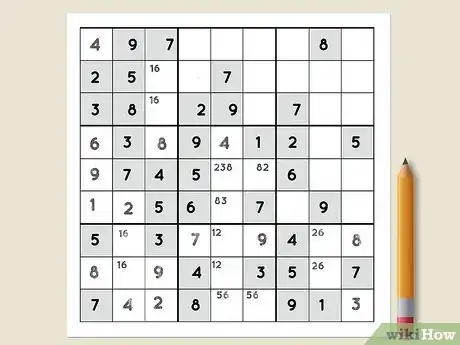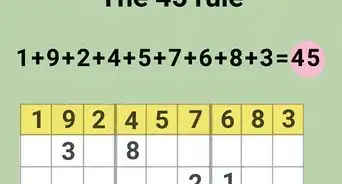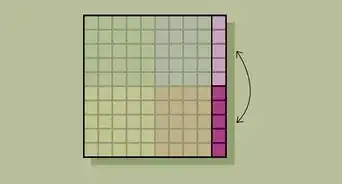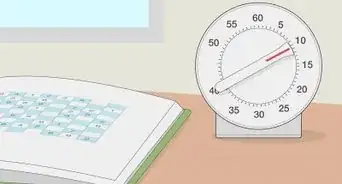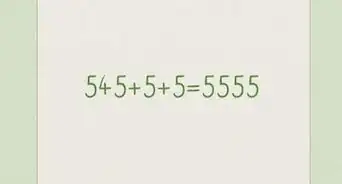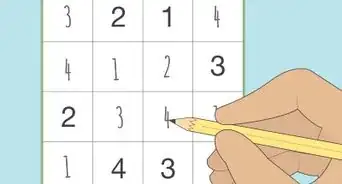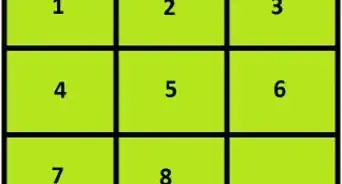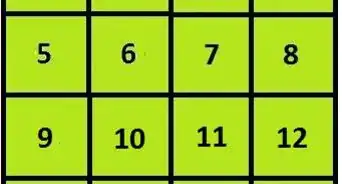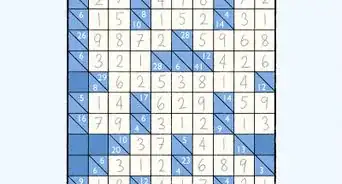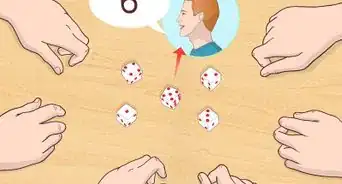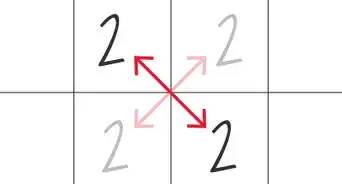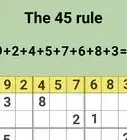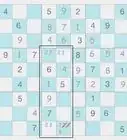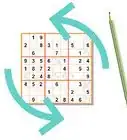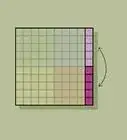This article was co-authored by wikiHow staff writer, Nihal Shetty. Nihal Shetty is a Writer and Editing Fellow at wikiHow who splits his time between Michigan and Mexico City. Before his role at wikiHow, he was an instructor of Russian literature at the University of California, Berkeley. Nihal received a BA in Comparative Literature from Columbia University and an MA in Russian at Berkeley.
There are 8 references cited in this article, which can be found at the bottom of the page.
This article has been viewed 23,377 times.
Learn more...
What’s a 3x3 in a Sudoku, and how can they help you solve these sometimes fiendish puzzles? A 3x3 is a set of 3 squares that can only be filled by 3 possible numbers, and you’ll discover them frequently as you work through a puzzle. Knowing how to spot them can turn a tough Sudoku into a much more manageable one. We’re here to show you exactly how to find a 3x3, how to use them to solve a puzzle, and give you additional tips for puzzle-solving in this complete guide on how to solve a 3x3 in a Sudoku puzzle.
Steps
Spotting and Solving 3x3s in Sudoku
-
1Spot easy-to-find 3x3s in blocks. A 3x3 happens when there are 3 squares that can only be filled by 3 potential numbers. When these 3 squares are in a block, they’re normally especially easy to spot.[1]
- In the above example, you’ll see that the top left block has 3 open squares that could only be filled by a 2, 3, or 6.
- Additionally, we can eliminate the 2 as a potential candidate for the middle square, since there’s a 2 located in that same row.
- Even better, we can eliminate 6 on the right-most square, since there’s a 6 in that column. These eliminations will make this 3x3 even easier to solve in the future.
-
2Look for less clear 3x3s in columns. Vertical columns are also a great place to spot 3x3s—each column and row needs to have every number from 1 to 9, not just each block. Remember to always keep columns in mind when solving a Sudoku.[2]
- In this example, notice that 2, 5, and 9 are the potential candidates for the missing squares in the vertical column.
- We can also eliminate 5 from the middle square, since there is another 5 in that row already.
Advertisement -
3Identify additional 3x3s in rows. The final potential place where you can find a 3x3 is in a horizontal row. The process here is the same: if you notice 3 squares that could only be filled by 3 potential candidates, you’ve got yourself a 3x3.[3]
- In this example, notice how the topmost row could only be filled by a 6, 7, or a 9. We can eliminate 7 from the middle square and 9 from the rightmost square, since these numbers are in the columns associated with those squares.
-
4Eliminate options to find hidden 3x3s. So far, we’ve covered what are called “naked 3x3s,” which happen when there are simply 3 empty boxes in a block, column, or row that can only be filled with 3 possible numbers. Hidden 3x3s occur when there are additional empty squares, but we can eliminate them as potential squares for the numbers in our 3x3.[4]
- In the above example, we can see a hidden 3x3 in the 3rd vertical column from the left.
- The column is missing not only a 2, 5, and 9, but also a 6 and an 8. But since a 6 and an 8 could only fill the two top right squares in the bottom left block, we know that those 2 squares must be either a 6 or an 8.
- Therefore, we know that we’ve found a 3x3 in the remaining squares in the column—although there’s no 9 in the row that belongs to the top right square in the bottom left block, we can eliminate 9 as a potential number to fill that square, since it is a part of the 3x3.
-
5Piece together other parts of the puzzle for clues to solve the 3x3. Once you’ve identified a 3x3, you might realize that there’s nothing more you can do to solve it immediately. But by continuing to solve the puzzle, you’ll eventually be able to solve for a number in the 3x3.[5]
- In the above example, imagine that you’ve continued in the puzzle and managed to find the locations of the blue 5 and 9. With this information, you now know that the green square must be a 2.
-
6Solve one square in the 3x3 to solve the other squares. Often (but not always), knowing what one square of the 3x3 is can allow you to deduce the answer to the other 2 squares. If you aren’t able to immediately solve the whole 3x3, don’t worry—finding more clues will eventually get you there.[6]
- In this example, since we know that the green square is a 2, we can deduce that the middle square of the 3x3 must be a 9. That leaves only 1 option for the final square of the 3x3: the 5 at the bottom.
Sudoku Strategies
-
1Begin with areas that have more digits. When looking for 3x3s, start with the low-hanging fruit—rows, columns, or blocks that already are filled with several numbers. These areas tend to be the easiest to solve, which can give you momentum when working on the puzzle.[7]
-
2Skip to a different part of the grid when you’re stuck. Moving on to a different part of the puzzle is an important part of solving most 3x3s, but always feel free to work on another part of the puzzle whenever you feel a little frustrated. Chances are you’ll find a new piece of information to make things much easier.[8]
-
3Use logic, not guesswork. Sudoku is a puzzle of logical deduction, meaning you won’t ever have to guess in order to solve the puzzle. Although there are plenty of advanced techniques for speedrunning puzzle-solvers, by slowly and logically working through the puzzle, you can take down even the toughest challenges.[9]
-
4Use a pencil. Although it might seem like basic advice, many Sudoku solvers forget that mistakes can happen in Sudoku. When they do, you’re going to want to make sure that you have an erasable pencil at hand.[10]
- Working on a Sudoku in pencil also makes it much easier to take notes as you go.
References
- ↑ https://youtu.be/4bvubRW48y0?t=54
- ↑ https://youtu.be/4bvubRW48y0?t=51
- ↑ https://youtu.be/4bvubRW48y0?t=46
- ↑ https://youtu.be/ZwrTGA5-pzs?t=129
- ↑ https://youtu.be/ZwrTGA5-pzs?t=342
- ↑ https://youtu.be/ZwrTGA5-pzs?t=342
- ↑ https://sudoku.com/how-to-play/how-to-solve-sudoku-puzzles-real-tips-and-advice-part-1/
- ↑ https://sudoku.com/how-to-play/how-to-solve-sudoku-puzzles-real-tips-and-advice-part-3/
- ↑ https://masteringsudoku.com/sudoku-tips-tricks/
